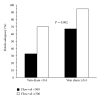Duplex ultrasound evaluation of hemodialysis access: a detailed protocol
- PMID: 22848824
- PMCID: PMC3400354
- DOI: 10.1155/2012/508956
Duplex ultrasound evaluation of hemodialysis access: a detailed protocol
Abstract
A detailed protocol for the performance and interpretation of duplex ultrasound evaluation of hemodialysis access is described.
Figures









References
-
- NKF-DOQI. NKF-DOQI clinical practice guidelines for vascular access. American Journal of Kidney Diseases . 1997;30(4, supplement):S150–S191. - PubMed
-
- KDOQI. Clinical practice guidelines for vascular access. American Journal of Kidney Diseases . 2006;48(supplement 1):S176–S247. - PubMed
-
- Silva MB, Jr., Hobson RW, II, Pappas PJ, et al. A strategy for increasing use of autogenous hemodialysis access procedures: impact of preoperative noninvasive evaluation. Journal of Vascular Surgery . 1998;27(2):302–308. - PubMed
-
- Ferring M, Henderson J, Wilmink A, Smith S. Vascular ultrasound for the pre-operative evaluation prior to arteriovenous fistula formation for haemodialysis: review of the evidence. Nephrology Dialysis Transplantation . 2008;23(6):1809–1815. - PubMed
LinkOut - more resources
Full Text Sources
Other Literature Sources

